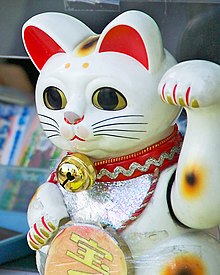The lucky cat maneki-neko is one of the most iconic symbols in Japanese culture, often seen in shops, restaurants, and homes.
Its friendly waving gesture and vibrant colors make it a beloved figure of good fortune.
This cat, commonly depicted with one paw raised in a beckoning gesture, is thought to bring prosperity, happiness, and good luck to its owner.
But where did the lucky cat maneki-neko come from, and what does it symbolize?
The Origins of the Maneki-Neko
The lucky cat maneki-neko has a long and fascinating history that dates back centuries in Japan. There are several theories surrounding its origins, but one popular story traces it to the Edo period (1603-1868). According to legend, a poor temple priest and his cat were struggling to survive. One day, the cat raised its paw and gestured towards a passing traveler, who, intrigued, entered the temple and made a generous donation. From that day forward, the priest’s fortunes improved, and the cat was seen as a symbol of good luck. This tale suggests that the lucky cat maneki-neko was a symbol of prosperity and an invitation for good fortune to come.
Another theory links the lucky cat maneki-neko to the practice of “maneki” or “beckoning.” In Japan, it was common for people to place images or statues of figures that were believed to attract wealth and success. The maneki-neko, with its raised paw and inviting gesture, was likely designed to symbolize the beckoning of positive energy and fortune. Over time, the image became ingrained in Japanese culture, especially in businesses, where it was thought to attract customers and bring success.
The Symbolism of the Maneki-Neko
The lucky cat maneki-neko is much more than just a cute and quirky decoration. Each part of the cat’s design carries symbolic meaning. The raised paw is the most obvious feature, but its position (left or right) is significant. If the cat raises its left paw, it is believed to bring in customers and business success. On the other hand, a raised right paw is said to attract wealth and financial prosperity. Some maneki-neko have both paws raised, which is thought to amplify the effect of both fortune and wealth.
The color of the lucky cat maneki-neko also carries meaning. The traditional white color symbolizes purity and happiness, while gold versions are believed to bring good luck and wealth. Black maneki-neko is often used to ward off evil spirits, and green is thought to bring protection for one’s health. Red maneki-neko has a special association with warding off bad luck and negative energy. The cat’s collar, often adorned with a bell or bib, adds another layer of symbolism, representing protection and the invitation of good fortune.
The Popularity of the Maneki-Neko
The lucky cat maneki-neko has become a global icon, not just in Japan but across the world. Its charm and good fortune symbolism have made it popular among people of various cultures. Businesses, especially restaurants, gift shops, and stores, often display a maneki-neko in the belief that it will bring them success and prosperity. You may find it in homes, too, as a lucky charm that promises wealth, protection, and good health to the family.
Throughout the years, the lucky cat maneki-neko has been adapted in countless ways. It appears in various materials, from ceramic to plush toys, and is frequently featured in pop culture. The basic concept of the cat’s wave remains unchanged, but creative adaptations continue to emerge, with some versions even featuring multiple paws or different expressions.
Maneki-Neko in Modern Times
In modern times, the lucky cat maneki-neko has transcended its traditional associations and become a symbol of cultural exchange. While originally used for practical purposes, such as attracting business and prosperity, it now represents a broader meaning of good luck and positive energy. Collectors often seek out rare versions of the maneki-neko, and artists frequently reimagine the figure in contemporary ways. The maneki-neko has also gained a strong presence in online shopping, where it is often used as a mascot or charm to promote good fortune for sellers and buyers alike.
Some contemporary depictions of the lucky cat maneki-neko even incorporate modern technology, with figures that wave on their own or have built-in motion sensors. This merging of traditional symbolism with technology demonstrates how the maneki-neko continues to adapt to modern life while retaining its historical roots.
Conclusion
The lucky cat maneki-neko is a rich and enduring symbol of good fortune, with a fascinating history that stretches across centuries and cultures. Whether in the form of a traditional ceramic figure or a modern digital icon, its symbolism remains the same: an invitation for prosperity, protection, and happiness. The lucky cat maneki-neko is not just a charming decoration; it’s a reminder of the hope that good things are just around the corner, beckoning us towards a brighter future.





